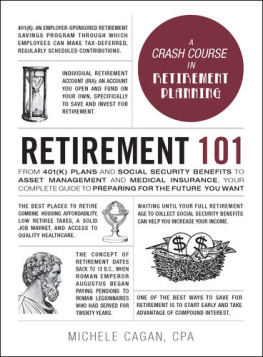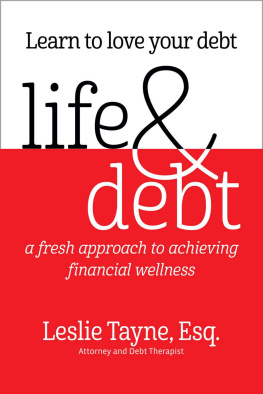Contents

Cover image: iStockphoto.com/Feng Yu
Cover design: Paul McCarthy
Copyright 2013 by Thomas J. Anderson. All rights reserved.
Published by John Wiley & Sons, Inc., Hoboken, New Jersey.
Published simultaneously in Canada.
No part of this publication may be reproduced, stored in a retrieval system, or transmitted in any form or by any means, electronic, mechanical, photocopying, recording, scanning, or otherwise, except as permitted under Section 107 or 108 of the 1976 United States Copyright Act, without either the prior written permission of the Publisher, or authorization through payment of the appropriate per-copy fee to the Copyright Clearance Center, Inc., 222 Rosewood Drive, Danvers, MA 01923, (978) 750-8400, fax (978) 646-8600, or on the Web at www.copyright.com . Requests to the Publisher for permission should be addressed to the Permissions Department, John Wiley & Sons, Inc., 111 River Street, Hoboken, NJ 07030, (201) 748-6011, fax (201) 748-6008, or online at http://www.wiley.com/go/permissions .
Limit of Liability/Disclaimer of Warranty: While the publisher and author have used their best efforts in preparing this book, they make no representations or warranties with respect to the accuracy or completeness of the contents of this book and specifically disclaim any implied warranties of merchantability or fitness for a particular purpose. No warranty may be created or extended by sales representatives or written sales materials. The advice and strategies contained herein may not be suitable for your situation. You should consult with a professional where appropriate. Neither the publisher nor author shall be liable for any loss of profit or any other commercial damages, including but not limited to special, incidental, consequential, or other damages.
For general information on our other products and services or for technical support, please contact our Customer Care Department within the United States at (800) 762-2974, outside the United States at (317) 572-3993 or fax (317) 572-4002.
Wiley publishes in a variety of print and electronic formats and by print-on-demand. Some material included with standard print versions of this book may not be included in e-books or in print-on-demand. If this book refers to media such as a CD or DVD that is not included in the version you purchased, you may download this material at http://booksupport.wiley.com . For more information about Wiley products, visit www.wiley.com .
Library of Congress Cataloging-in-Publication Data:
Anderson, Thomas J. (Certified investment management analyst)
The value of debt : how to manage both sides of a balance sheet to maximize wealth / Thomas J. Anderson, CIMA, CRPC.
pages cm
Includes bibliographical references and index.
ISBN 978-1-118-75861-8 (hardback); ISBN 978-1-118-75851-9 (ebk);
ISBN 978-1-118-75863-2 (ebk)
1. Finance, Personal. 2. Debt. I. Title.
HG179.A55976 2013
332.02402dc23
2013020675
For Sarah, John, Rosemary, and Oliver
Foreword
Change is the one constant in the financial services industry. In 1970, there were many days where trading volume on the New York Stock Exchange did not exceed 10 million shares. Recently, there have been multiple days with over 5 billion shares traded, an increase of 500 times. We have seen the development of integrated money market accounts, explosive growth in mutual funds, and the proliferation of such instruments as exchange-traded funds, separately managed accounts, hedge funds, private equity, structured products, and managed futures for commodities. This is taking place not just in the United States but across the world.
With time, advice has evolved as well. It had to. Clients have more investment choices than ever before. The global economy has become more interconnected and global capital markets have gone through explosive growth in both size and depth. The financial services industry has listened to the demands of its clients and responded accordingly. Investors today have the opportunity to invest in more asset classes through more vehicles in more places around the world than ever before.
So, where do we go from here? I had the opportunity to visit with Tom Anderson while he was putting together this book and he pointed out a glaring omission that I believe holds true for most all of us: throughout his primary school years, college education, graduate school, and professional life, Tom had not been educated as to the virtues of correctly structured debt. One can fill a library with books on debt strategies and capital structures for corporations, but there is virtually no material on the subject for individuals or families. Why? As I reflected on this some more, I found it shocking that there is not more material, education, debate, and discussion on this topic.
The financial industry has largely treated debt as though it were an outside force, considered and controlled independently of the rest of an individuals financial life. But who has not used a mortgage to finance a home, obtained a student loan to cover college tuition, or borrowed to buy a new car? It seems common sense to treat these moments of capital acquisition holistically, as part of an overall financial plan. However, this happens all too infrequently in practice. While most financial firms and advisors today are able to deliver integrated solutions by and large, they are not yet delivering integrated advice.
Most advisors give sound advice when it comes to equity but overlook the other half of the balance sheet. Getting sound advice on liability management can be critical especially during those first years of retirement. Tom has written a must-read book for anyone looking to make better financial decisions. This book should be a staple for Financial Advisors who want to do a complete job of advising their clients.
Toms background, at some of the top schools in finance in the United States and abroad, combined with his experience in investment banking and as a financial advisor, affords him a unique perspective to address this gap. His ideas come together in this book to deliver a new perspective that represents a substantial step forward toward a cohesive solution.
The excesses of debt and reckless lending at the heart of our recent financial crisis have been well documented. This is no reason to ignore debt as an effective financial arrow in your quiver. In fact, its all the more reason to approach debt in an intelligent and educated fashion. Whats true about investing is that it entails risk, yet can offer rewards. The same principle applies to a debt philosophy.
The ideas expressed in this book may or may not be appropriate for your individual situation. The most important contribution of this work is that it should create more questions than answers. These questions in turn should lead to quality, holistic conversations about all aspects of your financial life with your tax, legal, and financial advisors. Change is constant, but as the book describes, with integrated, holistic advice we can be better prepared for this change, and for the future ahead.
Robert D. Knapp
President
Supernova Consulting Group
Author of The Supernova Advisor: Crossing the Invisible
Bridge to Exceptional Client Service and Consistent Growth
Acknowledgments
This book is an amalgamation of all aspects of my education and career. I wish to thank my many professors at Washington University and The University of Chicagoyou have greatly influenced this work. To Professor Jaffe from the Wharton School of Business, Ill never forget the CIMA final exam, and I hope you see how often your textbook is cited in the endnotes, for those who want additional detail on corporate finance.

















